It will be a better year.
We had about 9 inches on Tuesday with another 4-5 coming on Friday. While I needed help with shoveling on Tuesday, I managed the next one mostly on my own. I made sure that I did not shovel for more than 15 minutes at a time. I am trying to develop shoveling muscles. The temperatures were in the 20's with little or no wind. It really was not so bad.
I must also declare that a three day weekend following a four day weekend could get addictive. At the same time it did seem like this weekend there were just two Saturdays in a row.
But there has been a lot to do. There was shoveling. With a new month I needed to do the room by room check on all the indoor plants. How are those plants that are hard to see? Do they need watering? Are there bugs?
It is time to officially start the new garden year.
I ceremoniously planted seeds. I planted some Iceland poppies and some lupines. I know from past years that they do well being started inside in January.
The orchids are a big hit at the moment, as you will see in the Right Now section down below. They allow you to remember flowers, just when the outside garden seems far away. In fact outside is all white, and is likely to stay that way for some time.
Let me get right to the Picture Contest.
The winner was the White Iceland Poppy. It will join the Red Iceland Poppy from Week #1 in the playoffs in 8 weeks. The countdown to spring has started. I actually thought there was good support for all the pictures last week.
For presentation, you should look at this version of the same picture.
Here is the final vote:
This Week is
Week #6
#1 Snowdrops
March 14, 2020
What a lovely group.
Snowdrops are such a good way to start the new year. They are the first sign of spring. How early they show up is all about snow cover. Last Sunday I thought I might have seen some finally coming up. Before I could take a picture, along came the snow. I do not think we will see the ground for some time.
I believe that this clump is galanthus nivalis. Galanthus is the genus. Nivalis is the species.
There is more about snowdrops in the Bonus section further down.
#2 Annual Asclepias
August 1, 2020
I love this annual asclepias. It is known as the tropical milkweed.
The genus is asclepoas. The species is curassavica. It is also called tropical milkweed.
The variety is also called Bloodflower or Sunset flower.
Here is an article from a Master Gardener webcite somewhere
It is an 'annual' for me in that it would not survive the winter, if left outside. As such it is different from most of the milkweeds, including the best known butterfly weed.
It would be a perennial in zone 8.
I have wintered this plant over the winter, inside for several years. If given a chance it will bloom inside. I brought in the same large pot for several years, until this fall. I decided that mother plant deserved a rest. So I just took in cuttings. It is the dream plant for cuttings. I think it makes roots in about ten days. After it is grown maybe 10 inches I can whack the top half off and start another plant in water. The lower portion then grows more shoots.
At this point I have 5 pots with another 6 shoots in water. And it is only the first of January.
The genus asclepias includes all the many milkweeds.
The plants are used for everything from medicine to poisoned arrows.
The purple in the background is Persian shield aka strobilanthes dyeriana. Another beautiful plant, also easy to grow from cuttings.
I read that this annual variety is not the best plant for the Monarch butterflies. It blooms until frost. Any Monarch that gets attracted to this late blooming plant might miss the bus south.
Do you know why plants in the milkweed group are called "milk"weed? It is because of the sap in the plant which is white. When I take a cutting the stem will drip with a slightly caustic white substance.
If you have the time look at the google images for milkweed. There are really so very many.
#3 White waterlily
July 21, 2020
This is the white waterlily. It has been in the contest before. Never before has it been presented in the way it appears in this picture. The pond does become 3D over the summer. Sometimes the blooming lilies can be a little hard to see.
We have had a still pond in the garden since my daughter Katie and a friend built it 30 years ago. It has no electricity. It balances the water elements of algae and bugs, by having water plants, sun, and some aquatic animals like fish and frogs.
The waterlilies are hardy, surviving in the frozen pond.
I divided the pots of these lilies two years ago. They needed it.
#4 Knight Rider
June 28, 2020
It really is almost black.
This dramatic lilium came to the garden in 2019. It came back quite well in 2020.
It is a cross between an Asiatic lily and a trumpet lily.
It blooms later than Fiamma for example.(from Week 2.) Fiamma was a cross between an Asiatic lily and an Easter lily. Those lilies. They sure get along with others in their group.
The name of this plant comes with a story.
If you look it up in catalogues, it is listed as 'Night Rider." That was part of the KKK during a time that would be left behind.
How can a lily have a racist name? Well after I realized what the name meant I looked into it. I contacted the lily company that had sold it to me. (It is available from many sources at this point.) The developers were in Holland. It was not that long ago. In Holland O learned, the TV show "Knight Rider" and its star David Hasseldorf, were/are very popular. So is the show Bay Watch. I do not think I ever saw either show.
Well, the Dutch growers named the lily after the show. I believe, the K was dropped in translation.
In other words it now has a racist name by mistake.
I was told that changing the name officially would be too hard.
So I have just changed the name in my garden.
#5 Banned in Boston
July 16, 2020
This has always been one of my favorite daylilies. It also has a great name. The pink petals with the green and yellow throat really go well together.
That is it for Week #6. Tell me what you think.
I should add that two people can vote on one computer if you just refresh your image after the first person votes.
Bonus Pictures
This picture of this solitary snowdrop was taken on January 2, 2020.
I thought I would look up snowdrops and give you some pieces of wisdom. I was amused at the title of one piece. It was titled 'how to care for snowdrops'. I did not think that required much of an exclamation. You put them in the ground and wait for them to come up. What else is there?
Here is the wikipedia
The genus is galanthus.
They have been around forever. They were mentioned in some old Greek texts from the fourth century B.C.
Brent and Becky's (one nice bulb company) lists 8 varieties. Elwesii and nivalis are the two most widely grown/known species. Nivalis is the most common. Elwesii is the bigger plant. I think of them as the clumping ones and the solitary. I say with about 80% confidence that nivalis is the clumper.
Here are more snowdrops pictures including several nice videos. The date is added. While snowdrops are the first spring flower, they bloom for a long time. That means the aconite and early crocuses join them, later in the wonderful spring celebration of the short early flowers.
I should add that the pictures are not necessarily the same clump.
 |
| January 2, 2020 |
I find it amazing how snowdrops, and the other early bulbs, can survive very low temperatures. They must have the equivalent of antifreeze in their DNA. The plant is a little bit warmer than the snow, sometimes making tiny holes around the plant.
 |
| February 3, 2020 |
 |
| February 7, 2020 |
 |
| February 23, 2020 |
 |
| March 7, 2020 |
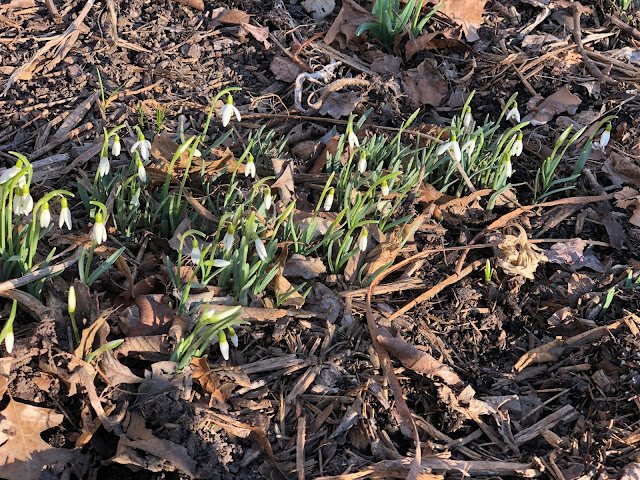 |
| March 8, 2020 |
 |
| March 14, 2020 |
This video was taken in the backyard on March 17, 2020. With not that much snow last year, the flowers were out in March. The snowdrops were joined by the winter aconite and the early crocuses.
There are garden wonders out there. This video was taken in the backyard of a neighbor. It had been hidden by a fence that came down at one point last winter. I had never seen anything like it before. This must be decades of steady growth, with little or no care. I imagine this must be what certain church yards in England look like.
The fence has been fixed. This year I will remember to look over the fence.
Waterlilies
It was a good garden year for waterlilies. It was a good garden year for many plants.
Here is the pond early in the year. The lily pads are all laying on the water with plenty of room.
 |
| May 23, 2020 |
For whatever reason, in a little more than a month, the waterlilies had become very 3D. I have considered the possibility that there are too many plants in the pond. At least at the moment the third dimension is kind of fun.
 |
| July 3, 2020 |
The white waterlilies have been in the picture contest before. A white waterlily was the winner in 2007 and 2012. I thought I would have a different type of picture this year. That is why I picked the contestant this week.
Here was the one that I ruled out in the last few weeks.
More Knight Riders.
I really should find a different color lily to plant with the black ones for accent. What color would be best? Yellow? Pink?
 |
| June 27 |
 |
| June 29 |
Right Now
'Right now' is all about orchids. They seem to be a perfect balance to the outside garden. Outside shuts down for 5-6 months. Then the orchids dazzle for just those months. About the time they are done, it is time to start the outside. Perfect.
Look at this collection. They are all in the dining room at the moment.
You may remember this next one from Week 1. It reliably blooms every Christmas.
The phalanopsis have begun to bloom. They will bloom for the next two months.
This great plant has been blooming now for 2 months. (Not the same flowers for that entire time.)
Julia's recipe this week
Dumplings
Here is the link to the other blog with all for Julia's recipes.
The term "dumplings" covers a lot of food, from meat-filled Asian wrappers to Southern biscuits floating in chicken stew. These dumplings come from my grandmother, a German woman who (before bein widowed and then coming to the U.S. in 1932) lived in what is now Serbia in a province called Banat. She had been married a Hungarian man so her cooking was a blend of German and Hungarian. As I have said before, she had theories about food at the New Year. One was to eat chicken on New Year's Eve to symbolize putting the old year behind us - the chicken scratches back. One was to eat pork of some kind on New Year's Day to symbolize moving forward into the new year - the pig pushes forward (with its snout). We often had chicken paprikash on New Year's Eve and other times too. Sometimes paprikash was served with rice or store-bought noodles. Sometimes my grandmother made these dumplings. They could be called shapeless noodles. Or starch blobs. Dumplings seems a more respectable name.

There are only 4 ingredients, counting water: 4 cups all purpose flour; 2 eggs; 2 teaspoons salt and 1-1/2 cups of water.
This makes a double batch. Which I advise. You can easily make half. The eggs come out even.
I put the flour in a bowl, added the salt, stirred the salt in and then added the eggs and the water.
I stirred it up and ended up with a slightly wet dough. I put a big pot of water on the stove and added 1 tablespoon of salt to the water.
When the water came to a boil, I got out a small cutting board, which I got thoroughly wet.
Then I scooped out some of the dough onto the cutting board. I dipped a silicone spatula in the hot water in the pot and used the wet spatula to spread the dough out a bit.
I got out a serving bowl and also turned the oven on to 200 degrees.
Next, I held the little cutting board over the pot of boiling water and used a paring knife to lop off bits (say 1" square) of dough and drop them into the water. Having 1" square dough strips is ideal, but any smallish lob is fine.
I used a slotted spoon to give the water a stir when the dough on the board was all in the pot. The dumplings can stick to the bottom. Then I stepped back. The dumplings are done when they float, which did not take more than a couple of minutes. I used the slotted spoon to fish them out. I put the dumplings in the bowl; put the bowl in the oven so the dumplings would stay warm and scooped out another blob of dough. I think it took four (maybe five) rounds to get all of the dumplings made.
This is a picture of me fishing dumplings
out of the pot of boiling water into the serving dish. Note the potholder. Even at 200 degrees, the bowl will get hot. Don't burn your hand.
Note also the big pot of paprikash on the back burner.
Here is the bowl of dumplings on the table, surrounded by orchids. There are seven orchids of different types blooming in the dining room at the moment. It's cozy.
And here is a bowl of chicken paprikash with dumplings. You should try it. The recipe for paprikash is in my blog ("in" or "on"?). It is also a simple dish in terms of ingredients: a little oil, a lot of onions, some salt, a lot of paprika, a chicken, and some water.
These dumplings could be served with beef stew or regular chicken soup. Delicious. Happy New Year.
Odds and ends
Who knew?
This is a regular milkweed. The flower is very similar to the annual asclepias.
I was pretty certain the picture was taken on one walk in the neighborhood. I then looked at some information icon shown with the picture. It told me it was taken near the corner of Muscatine Avenue and 7th Avenue. The fact that my phone stores that much information about its (and my) whereabouts is a bit disconcerting.
I thought I would post these two pictures of our grandchildren. This first picture is of Maisie, now 4 and a half months old. She is just figuring out that this is a great big world with lots of new things.
This was Christopher at about that age. He will be 4 years old in a few weeks. He has discovered musicals, including Singin' in the Rain. He likes to play Don Lockwood. Of course he also likes Music Man. I should mention that he is learning to tap dance.
We have been having 3-4 day weekends, which can be good. But we do manage to fill those quiet times with lots of activities. And that is still when we are not going out much or seeing anyone.
I find that odd.
17 more days
Say it again 17 more days.
We have had that countdown for almost 4 years.
At some point we will have one big celebration. But it will probably be by zoom.
Spring is coming.
It will be a time to mend, to heal, to remember our social skills.
Be safe.
Philip















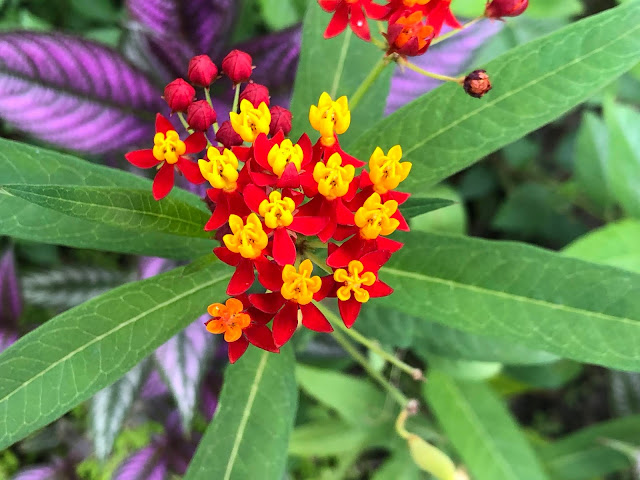



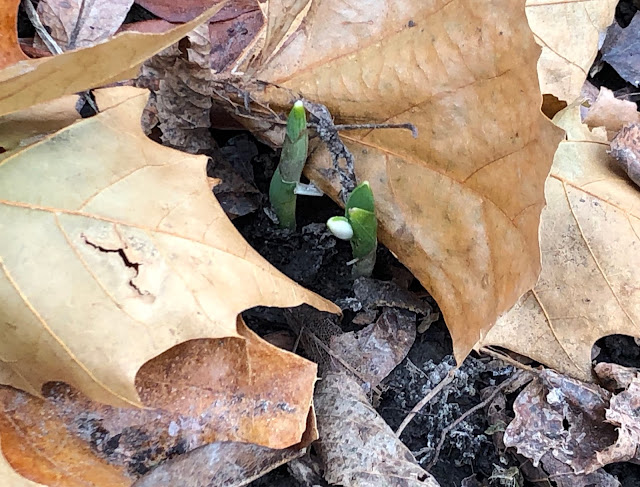







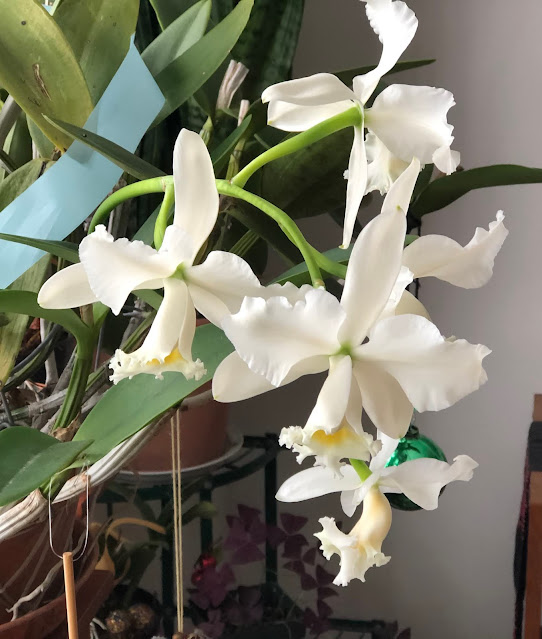
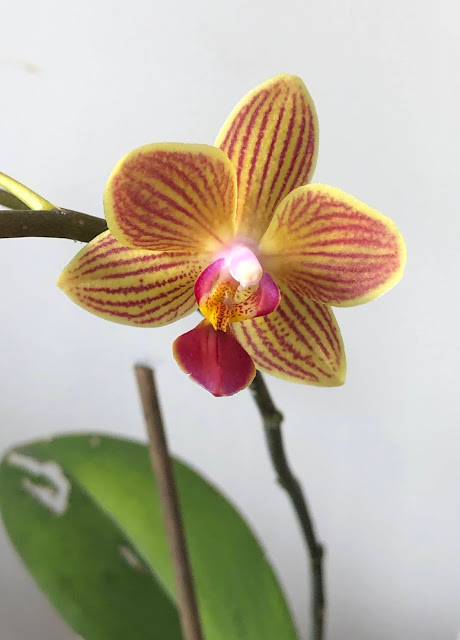

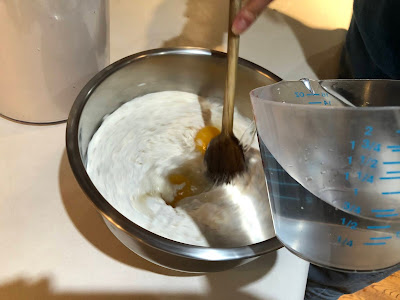


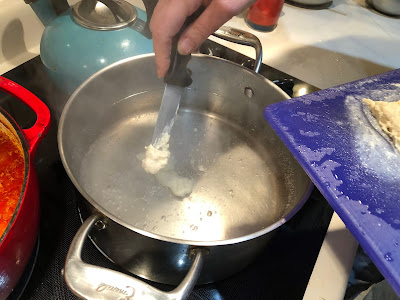






2 comments:
As for what color would go nicely with that dark lily, I think brilliant lime green would look nice--do lilies come in that color? Otherwise, bright orange. About callas & other bulbs in Florida: I caved in and bought a pot at the grocery story a couple of months ago, then unpotted the bulbs and planted them. They were fine. Let's see whether they come up again in 2021. Some lilies like it here and do come up in succeeding years.
Julia, thanks for that dumpling recipe. It sounds like one that my grandfather used to use for thick chunky egg noodles--the recipe was unfortunately never written down, but he used the same stuff. He dumped a pyramid of flour right onto the kitchen counter, cracked in a couple of eggs, stirred it up with his fingers, added a little water to get the right consistency, scooped it all up with a spatula and moved it to another part of the kitchen counter, which he'd coated with flour, rolled it all out thick with a rolling pin, then took a knife and cut it all into long strips, let it dry, then added to beef or chicken stew. Thick, lumpy, and very chewy noodles. But what a mess in the kitchen!
I've never voted for so many white flowers before. This week, the composition of the photograph was the deciding factor. But I don't expect it to win -- I'd guess #2 or #5 will win because of the gorgeous colors.
I've always been afraid to make dumplings, but I like how forgiving this recipe is in terms of the shape of the raw dough.
Post a Comment